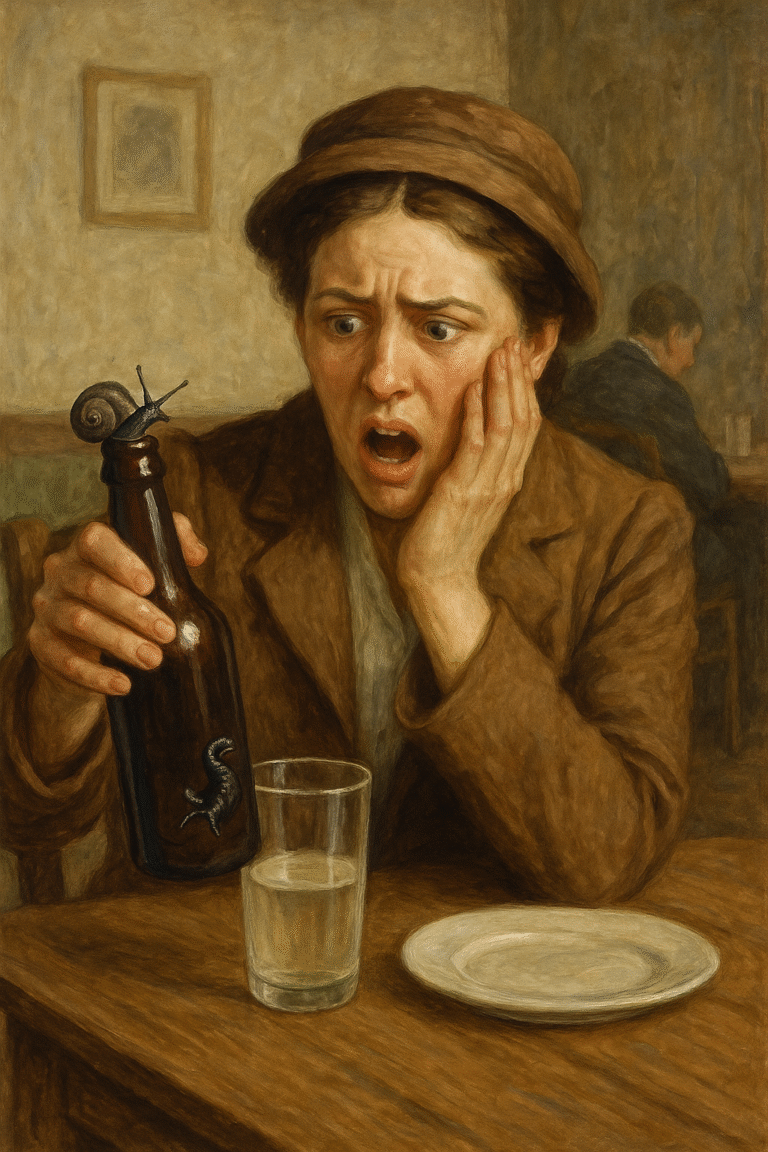In the historic Donoghue v. Stevenson case, a woman became sick after sipping ginger-beer that included a dead snail. The House of Lords’ decision changed negligence rules by making producers accountable for customer safety.
Imagine a pleasant August evening in 1928 in the energetic Scottish town of Paisley. Seeking a cool treat, shop worker May Donoghues enters a little café accompanied by a buddy. Popular combination at the time, her companion orders a bottle of ginger beer, topped over a scoop of ice-cream. David Stevenson, a nearby maker, names the black, opaque glass bottle capped with a metal cap. Unaware that her life is about to shift dramatically, May sips the bubbly concoction. Something terrible floats out as her companion dumps the last bits into the glass: a dead snail, its decomposing shape bobbing in the liquid. Not only from shock but also from the toxins May has already ingested, her stomach turns over. She gets sick with acute gastro-enteritis days later, her health destroyed by one drink.
This was not only a lousy café day. May Donoghue chose to strike back by suing Stevenson for carelessness. She had no contract with Stevenson and her buddy had bought the bottle; she wasn’t the buyer. As the maker, Stevenson was under obligation to make sure his product was safe for eating, the prosecution contended. The case revolved on a provocative question: Does a company owe consumers they never meet, even without a direct sale, a duty of care? In Scotland in the 1920s, when industrial output was soaring, this was a radical challenge to the legal system. The case would challenge the limits of negligence law, the pillar of tort law addressing civil wrongs.
Legal Action
The lawsuit started in Scotland’s Court of Session, where May, suing as a pauper because of her low income, battled uphill. The trial judge, the Lord Ordinary, thought her assertions strong. Should her claims be validated, he decided that they demonstrated a legitimate cause of action, therefore enabling the matter to move on for evidence-based trial. Stevenson’s defense said that since there was no contract between May and the manufacturer, her assertions had no bearing. Citing decisions like Mullen v. Barr & Co., where a mouse in a ginger-beer bottle did not result in manufacturer responsibility, they depended on precedent.
The appeal court, the Second Division of the Court of Session, disagreed with the Lord Ordinary nevertheless. Mostly, they discounted May’s case, remembering his decision. English and Scottish precedents saying producers have no duty to consumers without a contract obliged the courts. Lord Hunter disagreed, stating that the law should guard consumers against careless producers, particularly in cases when sealed bottles stop scrutiny.
Lead by George Morton K.C., May’s legal team appealed to the House of Lords, the highest court in the United Kingdom at the time. Given that Stevenson’s ginger-beer was bottled and sealed to reach customers directly, they maintained he had a responsibility to guarantee it was free from hazardous flaws. W.G. Normand, the defense, said that imposing such a responsibility would unfairly burden manufacturers, particularly without proof of willful damage. Though May’s assertions were accepted as factual for the appeal, concentrating just on whether her claims were legally acceptable, no witnesses testified concerning the snail’s source. The scene was ready for a landmark court ruling with ramifications for legal systems all around.
Court’s Decision and Justification
In Donoghue v. Stevenson, the House of Lords rendered a historic decision on May 26, 1932, reversing the Second Division’s rejection and thereby restoring the Lord Ordinary’s finding. The court decided, by a 3-2 majority, that May’s claims revealed a legitimate cause of action, therefore enabling her case to go before trial. The majority consisted in Lords Atkin, Thankerton, and Macmillan; Lords Buckmaster and Tomlin disagreed. The decision created the “neighbour principle,” a pillar of contemporary negligence law, whereby manufacturers would be held accountable for damage resulting from negligent manufacture.
The court’s thinking based on a number of important points:
Lord Atkin developed the neighbor concept, which holds that people have a reasonable duty of care to prevent acts that might reasonably hurt those “closely and directly affected” by their activities. By manufacturing food or drink in sealed containers, a company establishes a direct link with consumers—who depend on the safety of the product.
Most disagreed with the defense’s contention that culpability demanded a contractual tie. As a tort, negligence exists outside of contracts and shields consumers like May who use goods without direct purchase.
3. Foreseeable Harm: The court decided Stevenson, a reasonable producer, ought to have known that a flaw in his ginger-beer could endanger consumers. His duty of care was violated by his neglect of implementing sufficient inspection mechanisms.
4. Protection of Public Health: The decision underlined the need of maintaining public health. Food, drink, or pharmaceutical manufacturers have to make sure their products are free of flaws likely to cause harm, particularly in cases when consumers cannot check sealed goods.
5. Overruling Standard Practice: The court reversed Mullen v. Barr & Co., which had disallowed manufacturer liability under like circumstances. The majority concluded that earlier English decisions, including Winterbottom v. Wright, were not relevant since they dealt with different circumstances, such contractual violations instead of carelessness.
The dissenters, Tomlin and Lord Buckmaster, contended that enforcing a duty without a contract would burden producers and cause disturbance of trade. They drew on instances like Longmeid v. Holliday, in which responsibility was restricted to recognized flaws or intrinsically harmful products. Still, the majority’s progressive posture won out, changing tort law to mirror contemporary industrial reality.
Training and Final Thought
More than a tale about a snail in a bottle, the Donoghue v. Stevenson court ruling is a legal revolution safeguarding consumers all around. This case emphasizes for the common reader the ability of the judicial system to hold strong industries responsible. It reminds us that, even if they never meet you, the law expects manufacturers of a soda, snack, or medicine to give your safety top priority.
The decision communicates important signals to several interested parties:
For manufacturers: It is both moral and legal your duty to guarantee your goods are safe. Ignoring quality control or inspection standards could cause lawsuits and harm to reputation.
• To Consumers: You have rights even in absence of a clear contract. Should a product cause injury resulting from carelessness, the legal system provides means of redress, therefore enabling you to pursue justice.
Courts in the judicial system have to change with the demands of society. The House of Lords’s readiness to reject out-of-date precedents demonstrates how justice changes with time to strike a balance between fairness and pragmatic needs.
The relevance of this case is in its worldwide influence. Now guiding negligence law in nations including the UK, Canada, Australia, and beyond, the neighbor principle shapes many court decisions. For individuals harmed by negligent manufacturing, it is a ray of hope that guarantees no one, from a Paisley shop assistant to a consumer anywhere—suffers silently.
For May Donoghue, the struggle was personal and motivated by a café terror episode. But her bravery produced a legal legacy that safeguards everyone. Remember the law is on your side thanks to a snail that altered history the next time you open a bottle.
A disclaimer
Though it may include mistakes, this blog is a translation or overview of the original court ruling. Regarding any legal reference, kindly review the original ruling.




